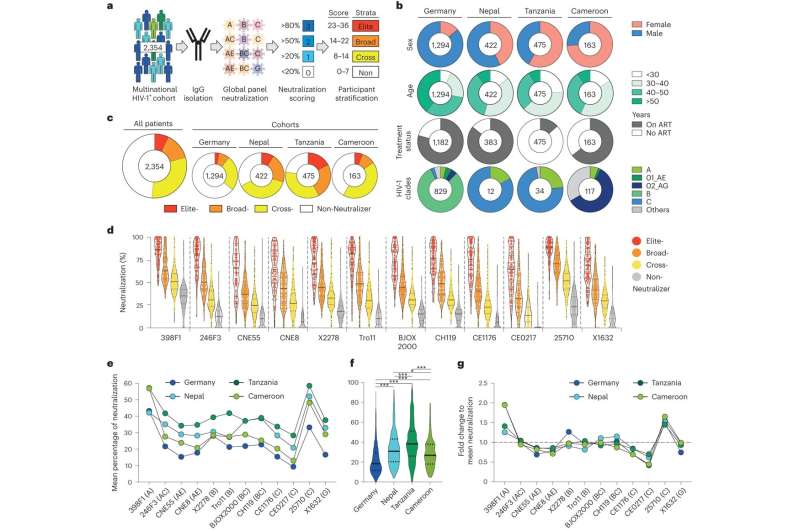This article has been reviewed according to Science X's editorial process and policies. Editors have highlighted the following attributes while ensuring the content's credibility:
fact-checked
peer-reviewed publication
trusted source
proofread
Another step toward the HIV-1 vaccine: Dynamics of neutralizing antibodies

An international team has for the first time researched the longevity of neutralizing antibodies in HIV-1-infected people. Currently, it is assumed that an HIV-1 vaccine can only be effective if it produces these antibodies in vaccinated humans. The findings improve understanding of the dynamics of such antibodies and are an important building block for further research into an HIV-1 vaccine.
Professor Dr. Florian Klein, Director of the Institute of Virology at the University Hospital Cologne, and Dr. Dr. Philipp Schommers, Head of the Laboratory for Antiviral Immunity at Department I of Internal Medicine of the University Hospital Cologne, were involved in the study. The publication was published under the title "Dynamics and durability of HIV-1 neutralization are determined by viral replication" in the journal Nature Medicine.
Dr. Schommers, first author of the study, reports, "We were able to show that the HIV-1 neutralization activity in patients strongly depends on the amount of virus in patients. While this dependence could be investigated in other infectious diseases, such as COVID-19, shortly after the initial description of the disease, the longevity of neutralizing antibodies in HIV-1 had not yet been shown in large studies."
Despite effective drugs that are the basis for treating the HIV-1 infection and can effectively prevent the transmission of the virus, over 1.2 million people are infected with HIV every year. Therefore, the development of an effective HIV-1 vaccine is still being intensely researched. So-called broadly neutralizing antibodies (bNAbs) can prevent HIV-1 infection.
Researchers are trying to induce such bNAbs through a vaccination in humans. However, this has proven to be extremely difficult. Therefore, vaccines that allow the formation of bNAbs in humans have not yet been developed. It is also unclear how long such broadly neutralizing antibodies remain in humans. However, this knowledge is extremely important in developing successful strategies for HIV-1 vaccination.
Therefore, the researchers led by Professor Klein and Dr. Schommers have investigated the HIV-1 antibody response in more than 2,300 patients from Germany, Tanzania, Cameroon, and Nepal. They identified various factors that cause patients to form neutralizing antibodies naturally. In addition, they identified so-called "elite neutralizers," i.e., HIV-1-infected individuals who build up a very potent and broadly neutralizing antibody response.
When the international research team examined HIV-1-infected individuals over time, it was then able to find out with what dynamics HIV-1 neutralizing antibodies can be sustained or the concentration of these antibodies can be further decreased in the blood. Here it was shown that the antibody response in these patients decreases over the years, but in them, highly potent bNAbs are detectable even after years. This is an important finding and indicates that a possible HIV-1 vaccine can trigger a permanent vaccine response.
More information: Philipp Schommers et al, Dynamics and durability of HIV-1 neutralization are determined by viral replication, Nature Medicine (2023). DOI: 10.1038/s41591-023-02582-3



















